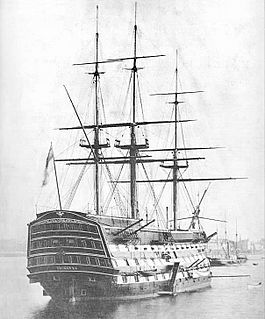Eight ships of the Royal Navy have been named HMS Royal George after various members of the House of Hanover. A ninth was renamed before being launched:

The Royal Navy (RN) is the United Kingdom's naval warfare force. Although warships were used by the English kings from the early medieval period, the first major maritime engagements were fought in the Hundred Years War against the Kingdom of France. The modern Royal Navy traces its origins to the early 16th century; the oldest of the UK's armed services, it is known as the Senior Service.

The House of Hanover, whose members are known as Hanoverians, is a German royal house that ruled Hanover, Great Britain, and Ireland at various times during the 17th through 20th centuries. The house originated in 1635 as a cadet branch of the House of Brunswick-Lüneburg, growing in prestige until Hanover became an Electorate in 1692. George I became the first Hanoverian monarch of Great Britain and Ireland in 1714. At Victoria's death in 1901, the throne of the United Kingdom passed to her eldest son Edward VII, a member of the House of Saxe-Coburg and Gotha. The last reigning members of the House lost the Duchy of Brunswick in 1918 when Germany became a republic.
- HMS Royal George was a 100-gun first-rate ship of the line launched as HMS Royal James in 1675. She was renamed HMS Victory in 1691, HMS Royal George in 1714 and HMS Victory again in 1715.
- HMS Royal George was a 100-gun first rate launched as Royal Charles in 1673 and renamed HMS Queen in 1693, HMS Royal George in 1715 and HMS Royal Anne in 1756.
- HMS Royal George (1756) was a 100-gun first rate launched in 1756. She served in the Seven Years' War and the American War of Independence and sank at Spithead in 1782.
- HMS Royal George (1776) was a 20-gun sloop listed as serving on the Canadian lakes in 1776.
- HMS Royal George (1788) was a 100-gun first rate launched in 1788 and broken up in 1822.
- HMS Royal George (1809) was a 20-gun sloop launched in 1809. She served on the Canadian lakes in the War of 1812, was renamed HMS Niagara in 1814 and was sold in 1837.
- HMY Royal George was a yacht launched in 1817 and broken up in 1905.
- HMS Royal George (1827) was a 120-gun first rate launched in 1827, fitted with screw propulsion in 1853 and sold in 1875.
- HMS Royal George was to have been a battleship, but she was renamed HMS King George V before she was launched in 1911.
HMS Royal James was a 100-gun first-rate ship of the line of the Royal Navy, designed by Sir Anthony Deane and built by his successor as Master Shipwright at Portsmouth Dockyard, Daniel Furzer, and launched in 1675. She was renamed HMS Victory on 7 March 1691 after the old second rate Victory of 1666 was condemned by survey and taken to pieces. Recommissioned in January 1691 under Captain Edward Stanley, as the flagship of Admiral Sir John Ashby she participated in the Battle of Barfleur on 19 May 1692 – 24 May 1692.

In the rating system of the British Royal Navy used to categorise sailing warships, a first rate was the designation for the largest ships of the line, equivalent to the 'super-dreadnought' of more recent times. Originating in the Jacobean era with the designation of Ships Royal capable of carrying at least 400 men, the size and establishment of first-rates evolved over the following 250 years to eventually denote ships of the line carrying at least 80 guns across three gundecks. By the end of the eighteenth century, a first-rate carried not less than 100 guns and more than 850 crew, and had a measurement (burthen) tonnage of some 2,000 tons.

A ship of the line was a type of naval warship constructed from the 17th through to the mid-19th century to take part in the naval tactic known as the line of battle, in which two columns of opposing warships would manoeuvre to bring the greatest weight of broadside firepower to bear. Since these engagements were almost invariably won by the heaviest ships carrying the most powerful guns, the natural progression was to build sailing vessels that were the largest and most powerful of their time.

